technical specifications JEEP RENEGADE 2014 1.G User Guide
[x] Cancel search | Manufacturer: JEEP, Model Year: 2014, Model line: RENEGADE, Model: JEEP RENEGADE 2014 1.GPages: 212, PDF Size: 17.48 MB
Page 174 of 212
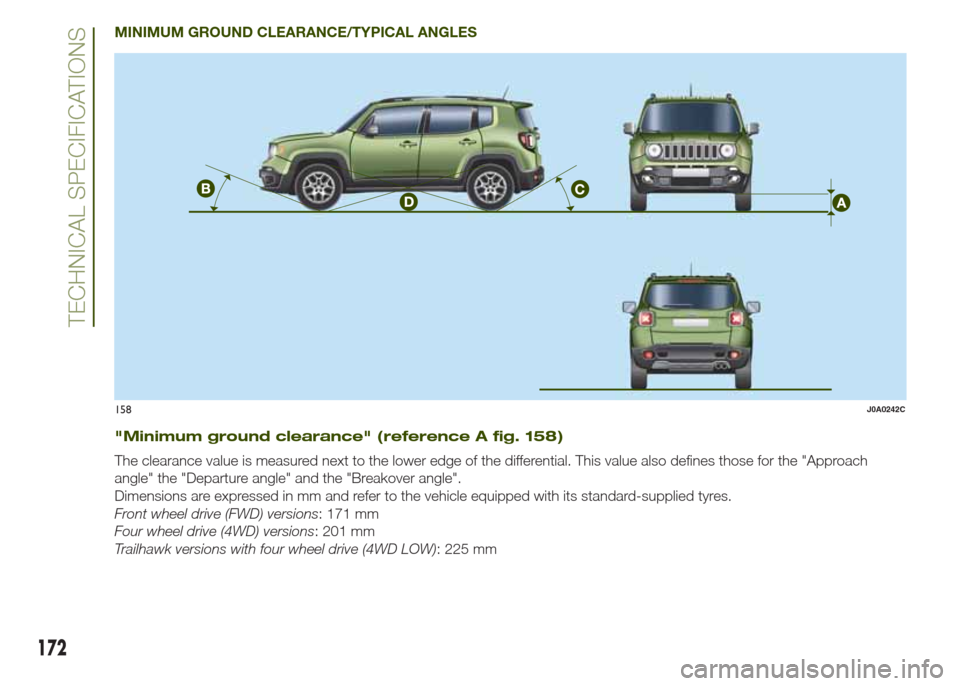
MINIMUM GROUND CLEARANCE/TYPICAL ANGLES
"Minimum ground clearance" (reference A fig. 158)
The clearance value is measured next to the lower edge of the differential. This value also defines those for the "Approach
angle" the "Departure angle" and the "Breakover angle".
Dimensions are expressed in mm and refer to the vehicle equipped with its standard-supplied tyres.
Front wheel drive (FWD) versions: 171 mm
Four wheel drive (4WD) versions: 201 mm
Trailhawk versions with four wheel drive (4WD LOW): 225 mm
158J0A0242C
172
TECHNICAL SPECIFICATIONS
Page 176 of 212
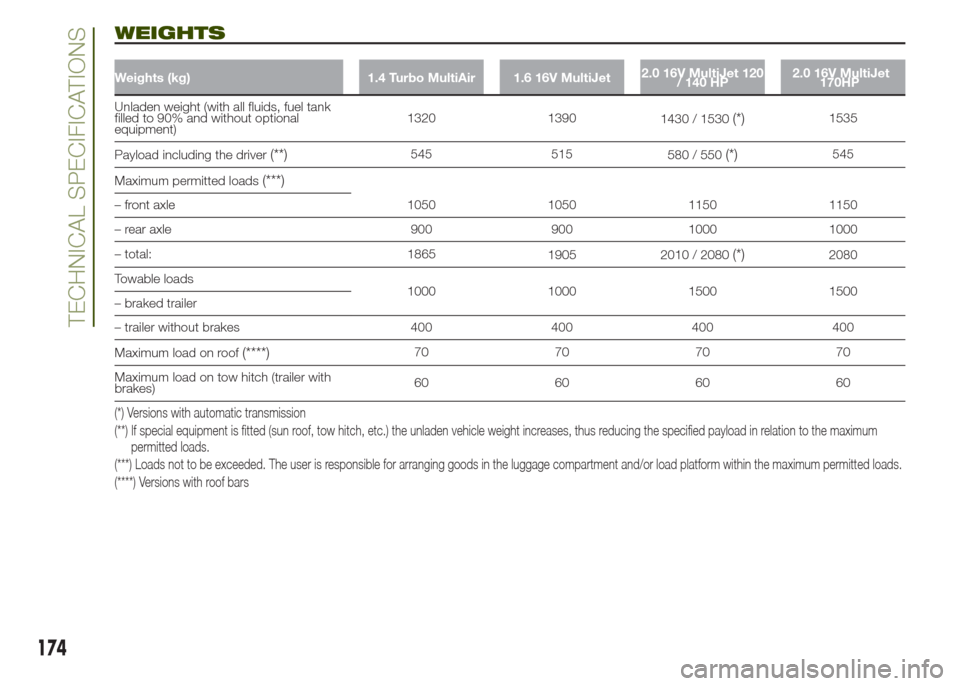
WEIGHTS
Weights (kg) 1.4 Turbo MultiAir 1.6 16V MultiJet 2.0 16V MultiJet 120 / 140 HP 2.0 16V MultiJet
Unladen weight (with all fluids, fuel tank filled to 90% and without optional equipment) 1320 1390 1430 / 1530(*)1535
Payload including the driver(**)545 515 580 / 550(*)545
Maximum permitted loads(***)
1050 1050 1150 1150 – front axle
– rear axle 900 900 1000 1000
– total: 1865 1905 2010 / 2080(*)2080
Towable loads 1000 1000 1500 1500 – braked trailer
– trailer without brakes 400 400 400 400
Maximum load on roof(****)70 70 70 70
Maximum load on tow hitch (trailer with brakes) 60 60 60 60
(*) Versions with automatic transmission
(**) If special equipment is fitted (sun roof, tow hitch, etc.) the unladen vehicle weight increases, thus reducing the specified payload in relation to the maximum permitted loads.
(***) Loads not to be exceeded. The user is responsible for arranging goods in the luggage compartment and/or load platform within the maximum permitt ed loads.
(****) Versions with roof bars
174
TECHNICAL SPECIFICATIONS
170HP
Page 178 of 212
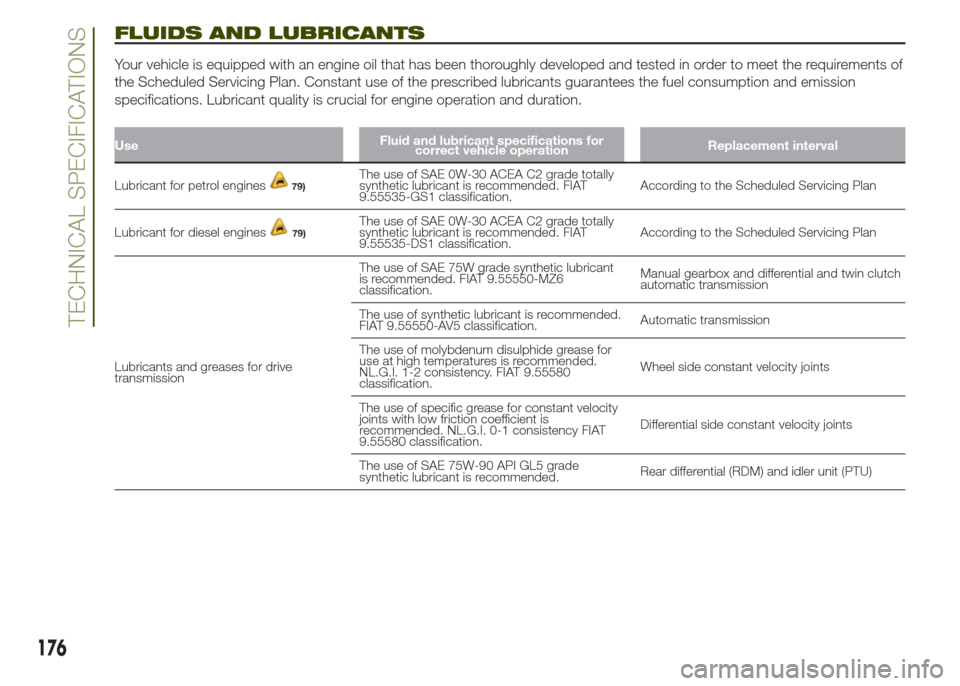
FLUIDS AND LUBRICANTS
Your vehicle is equipped with an engine oil that has been thoroughly developed and tested in order to meet the requirements of
the Scheduled Servicing Plan. Constant use of the prescribed lubricants guarantees the fuel consumption and emission
specifications. Lubricant quality is crucial for engine operation and duration.
UseFluid and lubricant specifications for
correct vehicle operationReplacement interval
Lubricant for petrol engines79)The use of SAE 0W-30 ACEA C2 grade totally
synthetic lubricant is recommended. FIAT
9.55535-GS1 classification.According to the Scheduled Servicing Plan
Lubricant for diesel engines
79)The use of SAE 0W-30 ACEA C2 grade totally
synthetic lubricant is recommended. FIAT
9.55535-DS1 classification.According to the Scheduled Servicing Plan
Lubricants and greases for drive
transmissionThe use of SAE 75W grade synthetic lubricant
is recommended. FIAT 9.55550-MZ6
classification.Manual gearbox and differential and twin clutch
automatic transmission
The use of synthetic lubricant is recommended.
FIAT 9.55550-AV5 classification.Automatic transmission
The use of molybdenum disulphide grease for
use at high temperatures is recommended.
NL.G.I. 1-2 consistency. FIAT 9.55580
classification.Wheel side constant velocity joints
The use of specific grease for constant velocity
joints with low friction coefficient is
recommended. NL.G.I. 0-1 consistency FIAT
9.55580 classification.Differential side constant velocity joints
The use of SAE 75W-90 API GL5 grade
synthetic lubricant is recommended.Rear differential (RDM) and idler unit (PTU)
176
TECHNICAL SPECIFICATIONS
Page 180 of 212
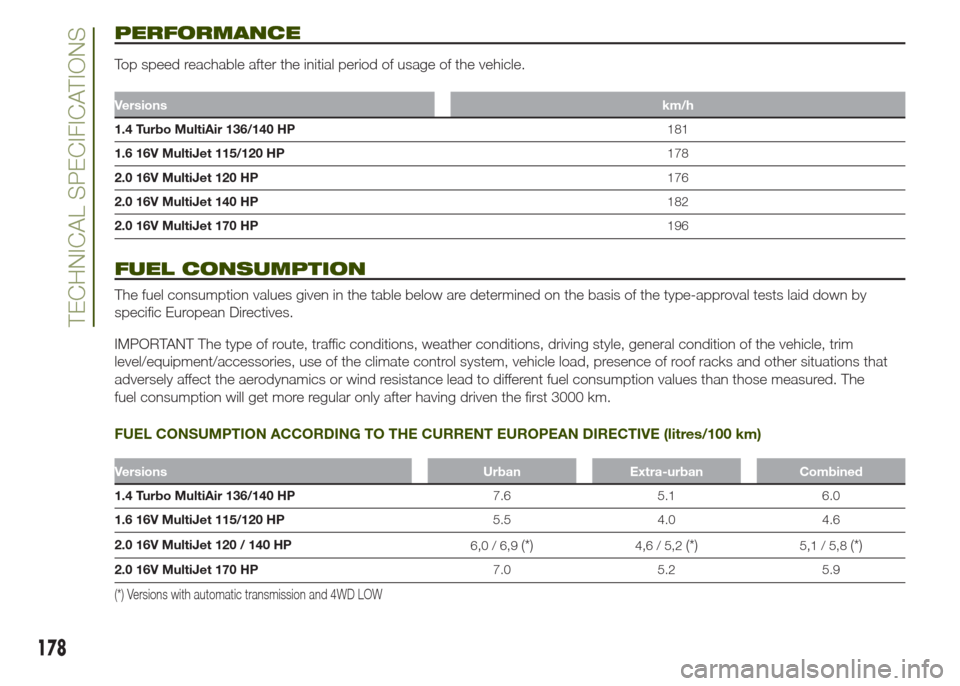
PERFORMANCE
Top speed reachable after the initial period of usage of the vehicle.
Versionskm/h
1.4 Turbo MultiAir 136/140 HP181
1.6 16V MultiJet 115/120 HP178
2.0 16V MultiJet 120 HP176
2.0 16V MultiJet 140 HP182
2.0 16V MultiJet 170 HP196
FUEL CONSUMPTION
The fuel consumption values given in the table below are determined on the basis of the type-approval tests laid down by
specific European Directives.
IMPORTANT The type of route, traffic conditions, weather conditions, driving style, general condition of the vehicle, trim
level/equipment/accessories, use of the climate control system, vehicle load, presence of roof racks and other situations that
adversely affect the aerodynamics or wind resistance lead to different fuel consumption values than those measured. The
fuel consumption will get more regular only after having driven the first 3000 km.
FUEL CONSUMPTION ACCORDING TO THE CURRENT EUROPEAN DIRECTIVE (litres/100 km)
Versions Urban Extra-urban Combined
1.4 Turbo MultiAir 136/140 HP7.6 5.1 6.0
1.6 16V MultiJet 115/120 HP5.5 4.0 4.6
2.0 16V MultiJet 120 / 140 HP
6,0 / 6,9
(*)4,6 / 5,2(*)5,1 / 5,8(*)
2.0 16V MultiJet 170 HP7.0 5.2 5.9
(*) Versions with automatic transmission and 4WD LOW
178
TECHNICAL SPECIFICATIONS
Page 203 of 212
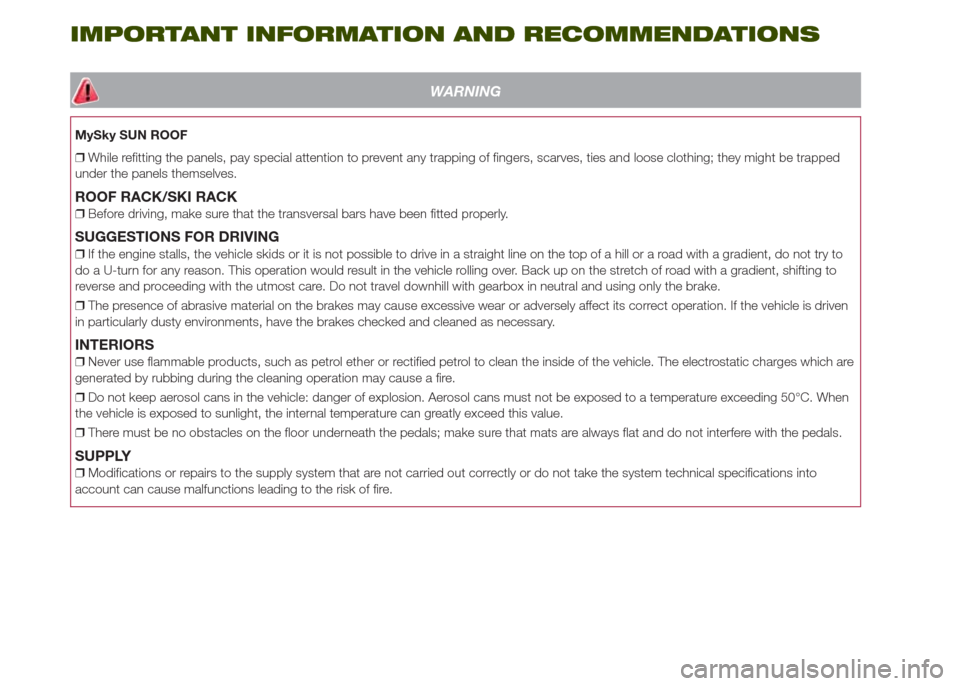
IMPORTANT INFORMATION AND RECOMMENDATIONS
WARNING
MySky SUN ROOF
❒While refitting the panels, pay special attention to prevent any trapping of fingers, scarves, ties and loose clothing; they might be trapped
under the panels themselves.
ROOF RACK/SKI RACK
❒Before driving, make sure that the transversal bars have been fitted properly.
SUGGESTIONS FOR DRIVING
❒If the engine stalls, the vehicle skids or it is not possible to drive in a straight line on the top of a hill or a road with a gradient, do not try to
do a U-turn for any reason. This operation would result in the vehicle rolling over. Back up on the stretch of road with a gradient, shifting to
reverse and proceeding with the utmost care. Do not travel downhill with gearbox in neutral and using only the brake.
❒The presence of abrasive material on the brakes may cause excessive wear or adversely affect its correct operation. If the vehicle is driven
in particularly dusty environments, have the brakes checked and cleaned as necessary.
INTERIORS
❒Never use flammable products, such as petrol ether or rectified petrol to clean the inside of the vehicle. The electrostatic charges which are
generated by rubbing during the cleaning operation may cause a fire.
❒Do not keep aerosol cans in the vehicle: danger of explosion. Aerosol cans must not be exposed to a temperature exceeding 50°C. When
the vehicle is exposed to sunlight, the internal temperature can greatly exceed this value.
❒There must be no obstacles on the floor underneath the pedals; make sure that mats are always flat and do not interfere with the pedals.
SUPPLY
❒Modifications or repairs to the supply system that are not carried out correctly or do not take the system technical specifications into
account can cause malfunctions leading to the risk of fire.